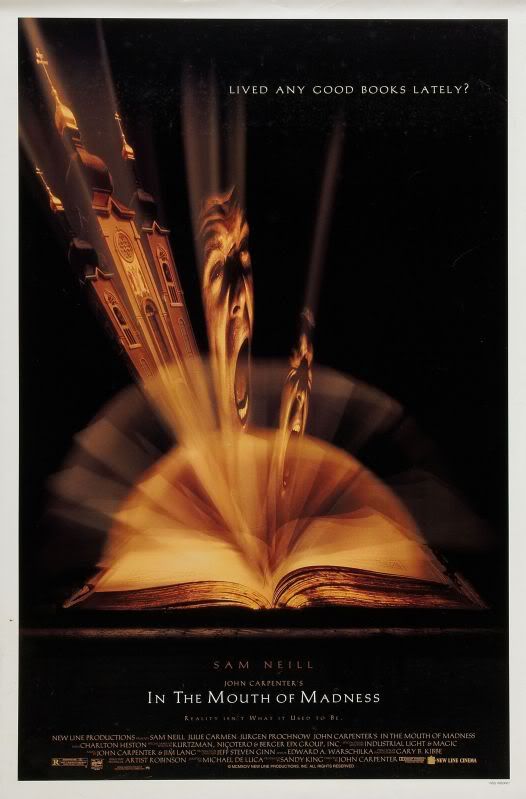
[No audio this week; RIP old headset. 🙁 ]
There are classics of the horror genre, speaking in terms of movies, that are all about the creatures: Bela Legosi’s Dracula, Boris Karloff as Frankenstein’s monster, Lon Chaney’s Wolfman and so on. Some horror stories move away from such “creature features” and opt for a more cerebral experience, inspired as they are by the works of Edgar Allen Poe or HP Lovecraft. These tales take it upon themselves to explore the inhumanity amongst our fellow man be that inhumanity inspired by simple madness or cosmic horrors. In The Mouth of Madness tries to be both, drawing inspiration from Lovecraft and directed by John Carpenter, helmsman of the 1982 sci-fi/horror classic The Thing.

When we meet John Trent, he’s in an asylum. Asked for his story, he relates that he was once an insurance investigator. A claim has been filed by Arcane Publishing against popular horror author Sutter Cane over the last novel in his bestselling series. After evading an attempt of Cane’s agent to axe-murder him, Trent takes the case, reads all of Cane’s work up to that mysterious final book and begins having nightmares. With the help of Cane’s editor, Linda, he manages to find the fictional New Hampshire town Cane used as a backdrop for his stories, and soon finds himself drawn into the mad novelist’s world to follow a sequence of events that may doom ours.
The material and feel of In The Mouth of Madness draw their fuel from the burning coals of many a Lovecraft story, but it’s hard not to notice the parallels with Stephen King. The fictional town of Hobb’s End into which our heroes stumble at first seems like a sleepy, friendly little place, but is soon consumed with madness and paranoia. The film, however, does not actually copy any particular character, event or story element from any of its contemporaries or inspirations, focusing instead on overarching themes and a mood of creeping dread. “Focus”, however, may be a strong word, because In The Mouth of Madness is kind of all over the place.

I happen to think Sam Neill is underappreciated. He’s brilliant in this.
As much as I appreciate movies that take pokes at the rabid behavior of certain subsets of genre fans, it was hard for me to be drawn into the story. Any time an atmosphere of dread seemed to be creeping in, a monster of one form or another would pop into the frame, if just for a moment, aimed at startling both the characters and the audience. Many of the good ideas in the plot – the madness caused by Cane’s books, the manifestation of the fictional town, the Lovecraftian ancient creatures bent on returning to Earth – are lost with the presence of one slavering grotesque leaping out at us going “ARE YOU SCARED YET?” after another. It’s disappointing as well as somewhat counter-productive.
Creature features are very different from deeper, psychological horror. When you watch, say, Bram Stoker’s Dracula or The Wolfman, you’re there for the lurid drama and a spattering of gore. Silence of the Lambs or Seven, on the other hand, is meant to invoke dark thoughts and feelings in a somewhat quiet way, their characters and actions very rooted in the real while being disturbingly abnormal. In The Mouth of Madness wants it both ways. In the end, it ends up being neither particularly introspective nor all that scary.

This scene had me laughing, not screaming, my head off.
This is a shame, as there are some interesting ideas at work. The fact that Cane’s novels inspire slaving mobs and axe-wielding agents could have sparked a discussion or investigation into the affect of media consumption on the populace. The town appearing out of nowhere from the pages of a book may have served an examination of the theory that worlds created by fiction do, in fact, exist somewhere. Even the movie’s attempt to transcend into a state of meta-awareness falls a bit flat due to the overwrought nature of its jump-out scares and unfocused narrative. It could be argued that this schizophrenic form of filmmaking is meant as an example of what schizophrenia itself might feel like, but even that explanation is flawed given the overall incoherency of the work. You may want to say something profound, but your meaning will be lost if all that comes out of your mouth is gibberish.
While I can’t say it’s a total failure, In The Mouth of Madness is neither an effective creature feature nor a true psychological horror. It relies too heavily on prosthetics and spook house slight-of-hand while not quite approaching the level of surrealism that makes surrealist works like Fear and Loathing in Las Vegas or Bad Lieutanant: Port of Call – New Orleans enjoyable and understandable to watch while still being batshit bonkers. Still, Sam Neill is a lot of fun to watch as he spirals out of reality and into his own little corner of Crazy Town, so if I were to recommend In The Mouth of Madness, it would be for an evening of MST3K-style fun with friends, rather than actually watching it for the sake of horror. You’ll probably get a much more palpable scare out of actually reading one of Lovecraft’s stories or, failing that, some horror-based fan fiction. Though that sort of thing is terrifying for entirely different reasons, especially when it manages to sell and someone starts making movies out of it. I’m not naming names. To do so would be to invite its attention. And those fans? They never sleep. They. Never. Sleep.
Josh Loomis can’t always make it to the local megaplex, and thus must turn to alternative forms of cinematic entertainment. There might not be overpriced soda pop & over-buttered popcorn, and it’s unclear if this week’s film came in the mail or was delivered via the dark & mysterious tubes of the Internet. Only one thing is certain… IT CAME FROM NETFLIX.



Leave a Reply